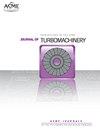考虑颗粒吸入叶片损伤影响的全级轴流压气机性能建模
IF 3.1
3区 工程技术
Q3 ENGINEERING, MECHANICAL
引用次数: 0
摘要
推进燃气轮机发动机吸入颗粒物造成的损害可能非常严重,影响电厂部件的可操作性和性能。在这里,我们关注的是轴流压缩机,其叶片在多尘/沙质环境中运行时会损坏,导致性能显著下降。在这项工作中,进行了CFD研究,以模拟翼型损伤对GE T700-401C压缩机一级转子叶片的影响。我们使用热塑性增材制造来构建三种损伤形态的代表性物理模型——弹道弯曲/弯曲前缘、前缘的裂纹侵蚀和外跨位置的侵蚀前缘/后缘。然后对由此产生的损坏的塑性几何形状和基线未损坏配置进行光学扫描,并将其纳入子层解析的全阶段非稳态RANS分析中。施加了符合损坏压缩机运行协议的边界条件,并提出了适应校正质量流量和非设计功率的迭代过程。从可压缩波场和二次流/叶尖流、展向性能参数分布和效率的角度研究了三种损伤和一种未损伤结构的结果。提出了一种估算转子损伤对发动机SFC影响的方法。此处所采用的代码、建模和网格划分策略与NASA转子37的验证研究一致——这些结果被简要包括在内,并为所研究的T700几何结构的预测提供了信心。这些结果提供了与损坏的压缩机性能退化相关的物理机制的定量比较和深入了解。本文章由计算机程序翻译,如有差异,请以英文原文为准。
Full Stage Axial Compressor Performance Modeling Incorporating the Effects of Blade Damage due to Particle Ingestion
The damage due to particulate matter ingestion by propulsion gas turbine engines can be significant, impacting the operability and performance of plant components. Here, we focus on the axial compressor whose blades become damaged when operated in dusty/sandy environments, resulting in significant performance degradation. In this work, CFD studies are performed to model the effects of airfoil damage on the first stage rotor blading of a GE T700-401C compressor. We use thermoplastic additive manufacturing to construct representative physical models of three damage morphologies – ballistically bent/curved leading edges, cragged erosion of leading edges, and eroded leading/tailing edges at outer span locations. The resultant damaged plastic geometries, and a baseline undamaged configuration are then optically scanned and incorporated into sublayer resolved full stage, unsteady RANS analyses. Boundary conditions are imposed that conform to damaged compressor operation protocols, and this iterative process for accommodating corrected mass flow and off-design powering is presented. The results for the three damaged and one undamaged configuration are studied in terms of compressible wave field and secondary/tip flows, spanwise performance parameter distributions and efficiency. A method to estimate the effect of rotor damage on engine SFC is presented. The code, modeling and meshing strategies pursued here are consistent with a validation study carried out for NASA Rotor 37 – these results are briefly included, and provide confidence in the predictions of the T700 geometry studied. The results provide quantitative comparisons of, and insight into, the physical mechanisms associated with damaged compressor performance degradation.
求助全文
通过发布文献求助,成功后即可免费获取论文全文。
去求助
来源期刊
CiteScore
4.70
自引率
11.80%
发文量
168
审稿时长
9 months
期刊介绍:
The Journal of Turbomachinery publishes archival-quality, peer-reviewed technical papers that advance the state-of-the-art of turbomachinery technology related to gas turbine engines. The broad scope of the subject matter includes the fluid dynamics, heat transfer, and aeromechanics technology associated with the design, analysis, modeling, testing, and performance of turbomachinery. Emphasis is placed on gas-path technologies associated with axial compressors, centrifugal compressors, and turbines.
Topics: Aerodynamic design, analysis, and test of compressor and turbine blading; Compressor stall, surge, and operability issues; Heat transfer phenomena and film cooling design, analysis, and testing in turbines; Aeromechanical instabilities; Computational fluid dynamics (CFD) applied to turbomachinery, boundary layer development, measurement techniques, and cavity and leaking flows.

 求助内容:
求助内容: 应助结果提醒方式:
应助结果提醒方式:


